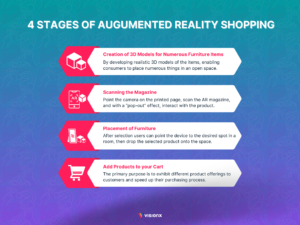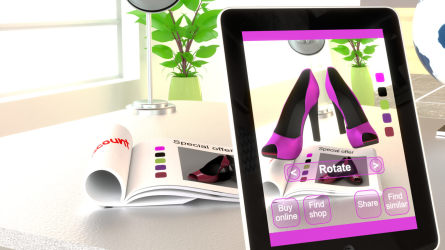The interminable COVID-19 crisis has transformed how, when, and where we shop and what we buy. Digital world has become more critical than ever; the devotion of different organizations has shaken. Ending levels are still beneath pre-crisis levels. COVID-19 pandemic has adversely powered company digitalization and the flight to e-commerce and prompted significant shifts in customers’ shopping behaviors — changes that we believe are here to stay.
Necessity is the mother of invention, and engineers have stepped up to the salver to deliver solutions to assist different organizations in overcoming their pandemic challenges. Augmented reality is at the vanguard of these solutions. It combines so many fiery significances— adding much-needed visualization tools, association competencies, and image recognition to prompt the right actions at the right time when it’s hard for us to stand in the same room and look at the same thing.
Augmented Reality: Solution to Retail Challenges
The usage of augmented reality in retail marketing has grown significantly. With in-person brand-to-consumer communication being so restricted because of a decline in traditional shopping, organizations have focused their attention on digital marketing to keep their products on top of mind in the eyes of customers. One technology that has seen great success is Augmented Reality. Not only does Augmented Reality allow consumers to try on products in real-time virtually, but it also allows them to customize their items – a dual hex of a personal virtual shopping experience. Providing this inclusive and seamless experience will provide you with a great substance of loyalty with your customers.
Personalization technology is crucial to crack authentic 1-to-1 customer experiences. Just think about it: when your customer designs a product, they’re putting in a lot more time and effort than they usually would when making a sale. Odds are, if they love the product they designed, they’re going to purchase it, and they’ll probably come back to buy from you in the future.
Augmented Reality is currently used by many industries including, the software industry, automobile, construction, advertising, and much more. Apart from this, one business using this technology to enhance its potential is the Furniture Industry. Augmented Reality is evidencing to be a game-changer in the furniture industry. Furniture retailers offer AR services to create virtual product catalogs, allowing their customers to check out products online, within context. The highly talented team at VisionX has been able to develop a new-age AR service tailored to the needs of the furniture industry. What are its silent features? Let us explain.
4 Phases of Augmented Reality Shopping
With a firm idea of what was needed to be achieved, we set to plan an AR application that was easy to use, flexible, and scalable to hold a growing catalog of products. We divided the project into different phases:
- Creation of 3D models for numerous furniture items
- Scan the printed Magazine
- Placement of Furniture
- Add products to your cart

1. Creation of 3D Models for Numerous Furniture Items
We wanted to handle this issue using augmented reality to assist our consumers with enhancing visualization, which they are keen on buying. We developed realistic 3D models of the furniture items, enabling our consumers to place numerous things in an open space to all the more likely examine a buy choice. Our objective was to keep the delivery of the models as exact to reality as could be expected. To achieve this, our team synchronized with texturing of the product-handled lighting and kept up with real-world mesh for all materials.
2. Scanning the Magazine
In the next stage of our project, we grabbed a printed magazine with item specifications. We allowed our consumers to view specifications of the furniture item, place the item within open space, and eventually make a purchase. We wanted to explore a more well-designed solution than a standard QR code, so we created the individual items on the page into tracked images that were recognized and “pulled out” from a page using machine learning. Our consumers simply point the camera on the printed page, scan the AR magazine, and with a “pop-out” effect, they could instantly interact with the product.
3. Placement of Furniture
Users can browse through different products from the AR magazine to make their selections. Once chosen, users must point the device to the desired spot in a room, then drop the selected product onto the space. Our app allows each user to save their favorite products and facilitate direct purchases through our app.
4. Add Products to your Cart
Lastly, the user can directly purchase through our AR app. All they have to do is click on Add to Cart, and boom, the product is added. The primary purpose is to exhibit different product offerings to our customers and speed up their purchasing process by seamlessly checking after getting comfortable with the products.
Beyond 2020 and The Covid-19 Pandemic
Even with vaccines rolling out, life will not go back to the way it was before the pandemic. We assume the repercussions of COVID-19 to last for years, if not decades. As far as our organization is concerned, we entail a new set of prospects. Our consumers will continue to expect virtual support. Pandemic-influenced buying behaviors will not change anytime soon. Augmented reality will continue to ease isolated association, give consumers a greater grasp, and create many opportunities for our consumer-based applications, even well after the pandemic is behind us.
If there’s anything the last year has taught us, it’s how nimble retail needs to and can be. Customers are no longer pleased with the status quo and expect us to be flexible to their ever-changing needs. We need to go to them and understand their needs. We need to make their shopping experience as simple and as enjoyable as scrolling social media.
